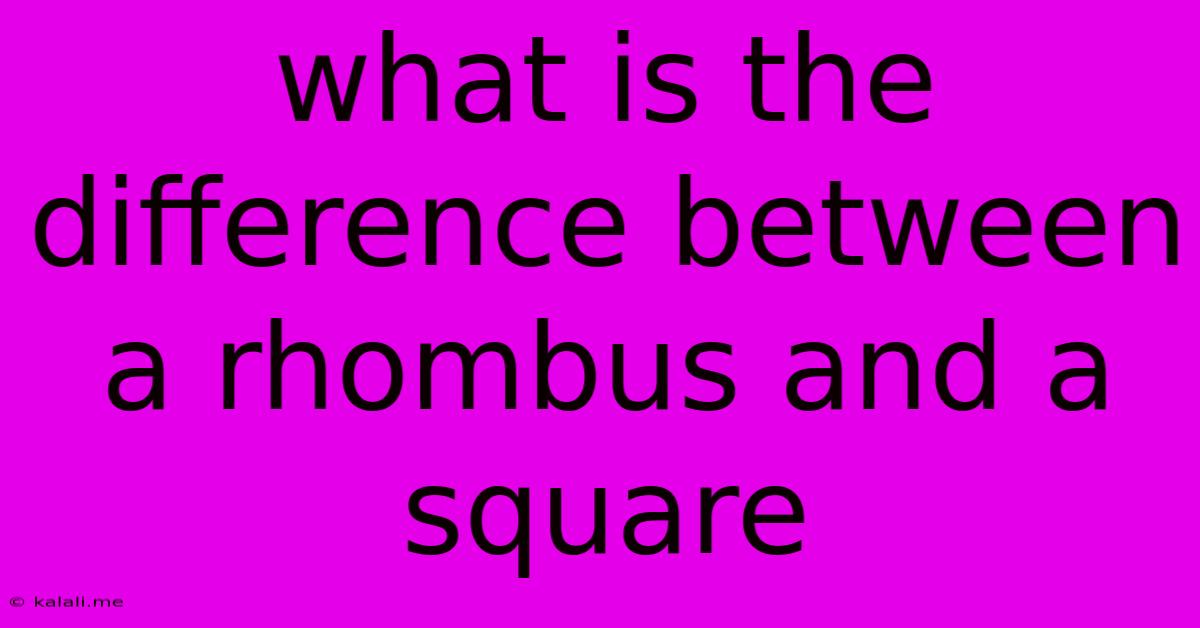What Is The Difference Between A Rhombus And A Square
Kalali
Jun 14, 2025 · 2 min read

Table of Contents
Rhombus vs. Square: Unveiling the Subtle Differences
Understanding the distinctions between a rhombus and a square can sometimes feel like navigating a geometric maze. While both are quadrilaterals (four-sided polygons) with parallel opposite sides, key differences in their angles and side characteristics set them apart. This article will clarify these differences, helping you confidently identify each shape.
What is a Rhombus?
A rhombus is a parallelogram, meaning its opposite sides are parallel and equal in length. However, unlike a rectangle, a rhombus doesn't necessarily have right angles. The defining characteristic of a rhombus is that all four sides are of equal length. This characteristic leads to its other properties, including opposite angles being equal and consecutive angles being supplementary (adding up to 180 degrees). Think of it as a "squashed" square.
Key Features of a Rhombus:
- Four equal sides: This is the most crucial defining feature.
- Opposite sides are parallel: A fundamental property of parallelograms.
- Opposite angles are equal: Another characteristic inherited from being a parallelogram.
- Consecutive angles are supplementary: Meaning they add up to 180 degrees.
- Diagonals bisect each other at right angles: The lines connecting opposite corners cut each other in half and form 90-degree angles.
What is a Square?
A square is a special type of rhombus (and also a special type of rectangle). It shares the properties of a rhombus – equal sides and parallel opposite sides – but with an added crucial condition: all four angles are right angles (90 degrees). This makes it a very regular and symmetrical shape.
Key Features of a Square:
- Four equal sides: Inherited from its rhombus classification.
- Four right angles (90 degrees): The defining difference from a rhombus.
- Opposite sides are parallel: A property shared with all parallelograms.
- Diagonals bisect each other at right angles: Similar to a rhombus.
- Diagonals are equal in length: Unlike a rhombus, the diagonals are of equal length in a square.
The Venn Diagram of Understanding:
Imagine a Venn diagram. The larger circle represents parallelograms. Inside that, a smaller circle represents rhombi (all rhombi are parallelograms). And finally, nestled perfectly within the rhombus circle, is the square. This illustrates that a square is a special case of a rhombus, possessing all its properties plus the additional property of having right angles.
In Summary:
The key takeaway is that every square is a rhombus, but not every rhombus is a square. A rhombus only requires equal sides, while a square demands both equal sides and right angles. Remembering this fundamental difference will help you confidently differentiate between these two important geometric shapes.
Latest Posts
Latest Posts
-
Florida Atlantic University Out Of State Acceptance Rate
Jun 15, 2025
-
The Storage Form Of Glucose In Plants Is
Jun 15, 2025
-
Which Movement Is Not Part Of A Biogeochemical Cycle
Jun 15, 2025
-
What Is The Si Unit For Inertia
Jun 15, 2025
-
How Many Significant Figures In 500 0
Jun 15, 2025
Related Post
Thank you for visiting our website which covers about What Is The Difference Between A Rhombus And A Square . We hope the information provided has been useful to you. Feel free to contact us if you have any questions or need further assistance. See you next time and don't miss to bookmark.